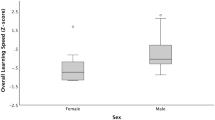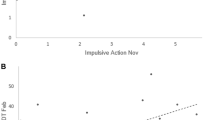Abstract
Animals adapt to changing environments by behaving flexibly when solving problems. Traits, such as sex and age, and specifically behavioral traits like persistence–the amount of time spent attempting to solve a problem, are positively associated with successful problem-solving. However, individuals face social pressures, such as aggression, which may directly alter an individual’s behavior or interact with sex or age, when they attempt to problem-solve. We examined the direct and indirect effects of social position and individual behavioral traits on solving a novel puzzle box in facultatively social yellow-bellied marmots (Marmota flaviventer), using both generalized linear mixed models and confirmatory path analysis. We found strong support that marmots who used a diversity of behaviors were more successful problem-solvers and weak support that those who received more aggression were less successful. Additionally, marmots who received more aggression were less behaviorally diverse, less behaviorally selective and less persistent while trying to open the puzzle box. Thus, we show that aggression indirectly decreases problem-solving success by acting on the behavioral traits that an individual uses. We conclude that specific social relationships, including the type of interaction and whether they are recipients or initiators, influences the ways in which an individual interacts with cognitive tests and should be considered in analysis of individual problem-solving.



Similar content being viewed by others
References
Armitage K (2003) Reproductive competition in female yellow-bellied marmots. In: Adaptive strategies and diversity in marmots, pp 133–142
Armitage K (2014) Marmot biology: sociality, individual fitness, and population dynamics. Cambridge University Press, Cambridge
Armitage KB (1991) Social and population dynamics of yellow-bellied marmots: results from long-term research. Annu Rev Ecol Syst 22:379–407. https://doi.org/10.1146/annurev.es.22.110191.002115
Bang A, Deshpande S, Sumana A, Gadagkar R (2010) Choosing an appropriate index to construct dominance hierarchies in animal societies: a comparison of three indices. Anim Behav 79:631–636. https://doi.org/10.1016/j.anbehav.2009.12.009
Barrat A, Barthélemy M, Pastor-Satorras R, Vespignani A (2004) The architecture of complex weighted networks. Proc Natl Acad Sci USA 101:3747–3752. https://doi.org/10.1073/pnas.0400087101
Barrett LP, Stanton LA, Benson-Amram S (2019) The cognition of ‘nuisance’ species. Anim Behav 147:167–177
Bates D, Mächler M, Bolker BM, Walker SC (2015a) Fitting linear mixed-effects models using lme4. J Stat Softw 67:1–48. https://doi.org/10.18637/jss.v067.i01
Bates D, Mullen KM, Nash JC, Varadhan, R (2015b) Package “minqa” Derivative-free optimization algorithms by quadratic approximation R package version 1.2.4. https://cran.r-project.org/web/packages/minqa/
Benson-Amram S, Dantzer B, Stricker G et al (2016) Brain size predicts problem-solving ability in mammalian carnivores. Proc Natl Acad Sci USA 113:2532–2537. https://doi.org/10.1073/pnas.1505913113
Benson-Amram S, Holekamp KE (2012) Innovative problem solving by wild spotted hyenas. Proc R Soc B Biol Sci 279:4087–4095. https://doi.org/10.1098/rspb.2012.1450
Benson-Amram S, Weldele ML, Holekamp KE (2013) A comparison of innovative problem-solving abilities between wild and captive spotted hyaenas, Crocuta crocuta. Anim Behav 85:349–356. https://doi.org/10.1016/j.anbehav.2012.11.003
Bergman TJ, Kitchen DM (2009) Comparing responses to novel objects in wild baboons (Papio ursinus) and geladas (Theropithecus gelada). Anim Cogn 12:63–73. https://doi.org/10.1007/s10071-008-0171-2
Blumstein D, Daniel J (2007) Quantifying behavior the JWatcher way. Sinauer Associates Incorporated, Sunderland
Blumstein DT (2013) Yellow-bellied marmots: insights from an emergent view of sociality. Philos Trans R Soc London B Biol Sci 368:20120349
Blumstein DT, Keeley KN, Smith JE (2016) Fitness and hormonal correlates of social and ecological stressors of female yellow-bellied marmots. Anim Behav 112:1–11. https://doi.org/10.1016/j.anbehav.2015.11.002
Blumstein DT, Wey TW, Tang K (2009) A test of the social cohesion hypothesis: Interactive female marmots remain at home. Proc R Soc B Biol Sci 276:3007–3012. https://doi.org/10.1098/rspb.2009.0703
Bonacich P (2007) Some unique properties of eigenvector centrality. Soc Netw 29:555–564. https://doi.org/10.1016/j.socnet.2007.04.002
Boogert NJ, Madden JR, Morand-Ferron J, Thornton A (2018) Measuring and understanding individual differences in cognition. Philos Trans R Soc B Biol Sci 373:20170280. https://doi.org/10.1098/rstb.2017.0280
Carey HV (1985) Nutritional ecology of yellow-bellied marmots in the White Mountains of California. Ecography 8:259–264. https://doi.org/10.1111/j.1600-0587.1985.tb01177.x
Chow PKY, Lea SEG, Leaver LA (2016) How practice makes perfect: the role of persistence, flexibility and learning in problem-solving efficiency. Anim Behav 112:273–283. https://doi.org/10.1016/j.anbehav.2015.11.014
Clutton-brock TH, Albon SD, Gibson RM, Guinness FE (1979) The logical stag: adaptive aspects of fighting in red deer (Cervus elaphus L.). Anim Behav 27:21–225
Cole EF, Morand-Ferron J, Hinks AE, Quinn JL (2012) Cognitive ability influences reproductive life history variation in the wild. Curr Biol 22:1808–1812. https://doi.org/10.1016/j.cub.2012.07.051
Csárdi G, Nepusz T (2006) The igraph software package for complex network research. InterJournal, complex Syst 1695:1–9
Daniels SE, Fanelli RE, Gilbert A, Benson-Amram S (2019) Behavioral flexibility of a generalist carnivore. Anim Cogn 22:387–396. https://doi.org/10.1007/s10071-019-01252-7
Evans A, Williams D, Blumstein D (2021) Producer-scrounger relationships in yellow-bellied marmots. Anim Behav 172:1–7
Frase BA, Armitage KB (1984) Foraging patterns of yellow-bellied marmosts: role of kinship and individual variability. Behav Ecol Sociobiol 16:1–10. https://doi.org/10.1007/BF00293098
Fuong H, Maldonado-Chaparro A, Blumstein DT (2015) Are social attributes associated with alarm calling propensity? Behav Ecol 26:587–592. https://doi.org/10.1093/beheco/aru235
Griffin AS, Diquelou M, Perea M (2014) Innovative problem solving in birds: a key role of motor diversity. Anim Behav 92:221–227. https://doi.org/10.1016/j.anbehav.2014.04.009
Griffin AS, Diquelou MC (2015) Innovative problem solving in birds: a cross-species comparison of two highly successful passerines. Anim Behav 100:84–94. https://doi.org/10.1016/j.anbehav.2014.11.012
Griffin AS, Guez D (2014) Innovation and problem solving: a review of common mechanisms. Behav Process 109:121–134. https://doi.org/10.1016/j.beproc.2014.08.027
Griffin AS, Lermite F, Perea M, Guez D (2013) To innovate or not: contrasting effects of social groupings on safe and risky foraging in Indian mynahs. Anim Behav 86:1291–1300. https://doi.org/10.1016/j.anbehav.2013.09.035
Huang B, Wey TW, Blumstein DT (2011) Correlates and consequences of dominance in a social rodent. Ethology 117:573–585. https://doi.org/10.1111/j.1439-0310.2011.01909.x
Keagy J, Savard JF, Borgia G (2009) Male satin bowerbird problem-solving ability predicts mating success. Anim Behav 78:809–817. https://doi.org/10.1016/j.anbehav.2009.07.011
Kendal RL, Coe RL, Laland KN (2005) Age differences in neophilia, exploration, and innovation in family groups of callitrichid monkeys. Am J Primatol. https://doi.org/10.1002/ajp.20136
Keynan O, Ridley AR, Lotem A (2016) Task-dependent differences in learning by subordinate and dominant wild Arabian babblers. Ethology 122:399–410. https://doi.org/10.1111/eth.12488
Kuznetsova A, Brockhoff PB, Christensen RHB (2017) lmertest package: tests in linear mixed effects models. J Stat Softw 82:1–26. https://doi.org/10.18637/jss.v082.i13
Lazzaroni M, Range F, Bernasconi L et al (2019) The role of life experience in affecting persistence: a comparative study between free-ranging dogs, pet dogs and captive pack dogs. PLoS ONE 14:e0214806. https://doi.org/10.1371/journal.pone.0214806
Lefcheck JS (2016) piecewiseSEM: piecewise structural equation modelling in r for ecology, evolution, and systematics. Methods Ecol Evol 7:573–579. https://doi.org/10.1111/2041-210X.12512
Loepelt J, Shaw RC, Burns KC (2016) Can you teach an old parrot new tricks? Cognitive development in wild kaka (Nestor meridionalis). Proc R Soc B Biol Sci 283:20153056. https://doi.org/10.1098/rspb.2015.3056
MacDougall-Shackleton E, MacDougall-Shackleton S, An YS, Kriengwantana B, Newman A (2011) Social rank, neophobia and observational learning in black-capped chickadees. Behaviour 148(1):55–69
Manrod JD, Hartdegen R, Burghardt GM (2008) Rapid solving of a problem apparatus by juvenile black-throated monitor lizards (Varanus albigularis albigularis). Anim Cogn 11:267–273. https://doi.org/10.1007/s10071-007-0109-0
Montero AP, Williams DM, Martin JGA, Blumstein DT (2020) More social female yellow-bellied marmots, Marmota flaviventer, have enhanced summer survival. Anim Behav 160:113–119. https://doi.org/10.1016/j.anbehav.2019.12.013
Opsahl T (2013) Triadic closure in two-mode networks: Redefining the global and local clustering coefficients. Soc Networks 35:159–167. https://doi.org/10.1016/j.socnet.2011.07.001
Overington SE, Cauchard L, Côté KA, Lefebvre L (2011) Innovative foraging behaviour in birds: What characterizes an innovator? Behav Processes 87:274–285. https://doi.org/10.1016/j.beproc.2011.06.002
Pielou E (1975) Ecological diversity. Wiley, New York
Pinheiro J, Bates D, DebRoy S, Sarkar D, Team RC (2019) nlme: Linear and nonlinear mixed effects models. R package version 3.1-140. https://cran.r-project.org/web/packages/nlme/index.html
Preacher KJ, Zyphur MJ, Zhang Z (2010) A general multilevel SEM framework for assessing multilevel mediation. Psychol Methods 15:209–233. https://doi.org/10.1037/a0020141
R Core Team. (2019) R: a language and environment for statistical computing. https://www.r-project.org/
Reader S, Laland K (2003) Animal innovation: an introduction. Animal innovation. Oxford University Press, Oxford, pp 3–38
Reader SM, Laland KN (2001) Primate innovation: sex, age and social rank differences. Int J Primatol 22:787–805. https://doi.org/10.1023/A:1012069500899
Revelle W (2018) Psych: procedures for personality and psychological research. Northwestern University, Evanston
RStudio Team (2020) RStudio: Integrated Development for R. RStudio, PBC. http://www.rstudio.com/
Shipley B (2000) Cause and correlation in biology a user’s guide to path analysis, structural equations and causal inference with R. Cambridge University Press, Cambridge
Sih A, Trimmer PC, Ehlman SM (2016) A conceptual framework for understanding behavioral responses to HIREC. Curr Opin Behav Sci 12:109–114
Sol D, Duncan RP, Blackburn TM et al (2005) Big brains, enhanced cognition, and response of birds to novel environments. Proc Natl Acad Sci USA 102:5460–5465. https://doi.org/10.1073/pnas.0408145102
Sol D, Lefebvre L, Rodríguez-Teijeiro JD (2005) Brain size, innovative propensity and migratory behaviour in temperate Palaearctic birds. Proc R Soc Lond B Biol Sci 2005:272
Tebbich S, Fessl B, Blomqvist D (2009) Exploration and ecology in Darwin’s finches. Evol Ecol 23:591–605. https://doi.org/10.1007/s10682-008-9257-1
Thornton A, Samson J (2012) Innovative problem solving in wild meerkats. Anim Behav 83:1459–1468. https://doi.org/10.1016/j.anbehav.2012.03.018
Wasserman S, Faust K (1994) Social network analysis: Methods and applications (Vol 8). Cambridge University Press, Cambridge
Watts DJ, Strogatz SH (1998) Collective dynamics of ‘small-world’ networks. Nature 393(6684):440–442
Wey T, Blumstein DT, Shen W, Jordán F (2008) Social network analysis of animal behaviour: a promising tool for the study of sociality. Anim Behav 75:333–344. https://doi.org/10.1016/j.anbehav.2007.06.020
Wey TW, Blumstein DT (2012) Social attributes and associated performance measures in marmots: bigger male bullies and weakly affiliating females have higher annual reproductive success. Behav Ecol Sociobiol 66:1075–1085. https://doi.org/10.1007/s00265-012-1358-8
Wey TW, Blumstein DT (2010) Social cohesion in yellow-bellied marmots is established through age and kin structuring. Anim Behav 79:1343–1352. https://doi.org/10.1016/j.anbehav.2010.03.008
Williams DW, Evans A, Briana B, Blumstein DT. Can a generalist herbivore learn to problem-solve? (in preparation)
Acknowledgements
We thank the 2018 Marmoteers (Alex Jebb, Alyssa Morgan, Nitin Vincent, Julia Nelson, Anita Montero, Katherine Ziska, Eliza Foli) for keeping the puzzle boxes up and the video crew (Andrew Evans, Nicole Ugorji, Briana Barr, Griffin Nicholson, Grace Kim, Samantha Ono, Roger Zhang and Chloe Tilton) for their help in managing the videos. Additional thanks to Aimee Classen, Ben Blonder, Noa Rigoudy, and Andy Lim and Siavash Jalal (UCLA statistical consulting) for help interpreting SEM models. We thank the Blumstein Lab group, Noa Pinter-Wollman, Peter Nonacs, Greg Grether, and two anonymous reviewers for their constructive feedback on various versions of this paper.
Funding
D.M.W. was supported by an Animal Behavior Society Student Research Grant, an American Society of Mammologists Grants-in-Aid of Research, a UCLA EEB Fellowship, and a National Science Foundation Graduate Research Fellowship (DGE-1650604). C.W. was a National Science Foundation Research Experience for Undergraduates Fellow under D.T.B. at the time of this research. D.T.B. was supported by the National Science Foundation (DEB 1557130 to D.T.B., as well as D.B.I. 1646666 to the Rocky Mountain Biological Laboratory).
Author information
Authors and Affiliations
Contributions
Conceptualization, DMW, DTB and CW; methodology DTB and DMW; investigation DMW and CW; formal analysis DTB, DMW and CW; writing-original draft DMW and CW; writing—review & editing DMW, DTB and CW; resources DMW and DTB.
Corresponding author
Ethics declarations
Conflicts of interest
The authors declare that they have no conflict of interest.
Ethics approval
The marmot study population is free-living and could freely interact with or leave the puzzle box as they desired. None were harmed by interacting with the box. Injuries are very rare during trapping and typically involves scrapes that are treated during handling. Marmots were studied under ARC protocol 2001-191-01 by the University of California Los Angeles Animal Care Committee on 13 May 2002, and renewed annually, as well as annual permits issued by the Colorado Division of Wildlife (TR519) and the Rocky Mountain Biological Laboratory’s Animal Care Committee.
Additional information
Publisher's Note
Springer Nature remains neutral with regard to jurisdictional claims in published maps and institutional affiliations.
Supplementary Information
Below is the link to the electronic supplementary material.
Supplementary file2 (MP4 31692 KB)
Rights and permissions
About this article
Cite this article
Williams, D.M., Wu, C. & Blumstein, D.T. Social position indirectly influences the traits yellow-bellied marmots use to solve problems. Anim Cogn 24, 829–842 (2021). https://doi.org/10.1007/s10071-020-01464-2
Received:
Revised:
Accepted:
Published:
Issue Date:
DOI: https://doi.org/10.1007/s10071-020-01464-2




